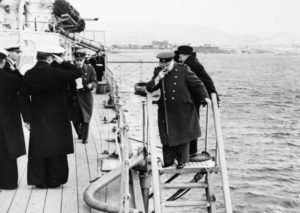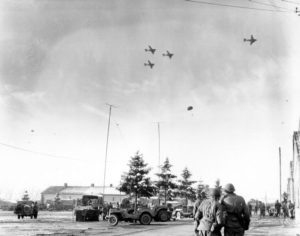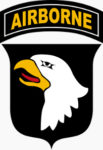
Winston Churchill leaving HMS Ajax in Piraeus harbour, Greece, to attend a conference ashore, December 1944 [Public domain]
This week in the war on 25 December, Christmas Day 1944, Winston Churchill flew into Kalamaki airfield near Athens, after a brief refueling stop in Naples.
Churchill and his delegation spent the night on board the British cruiser HMS Ajax (of Battle of the River Plate fame), which was anchored in Piraeus harbor.
Archbishop Damaskinos, of the Greek Orthodox Church, came on board to discuss the threat of an armed Communist takeover in Greece—a threat which had prompted Churchill’s dramatic flight from England in the middle of winter.
The following day, the Communists (notably ELAS–the Greek People’s Liberation Army) were invited to a conference at the Greek Foreign Office in Athens. It was agreed that the King of Greece would be asked to appoint the Archbishop as Regent, with the understanding that Damaskinos would form a new government for the country.
Fighting between Greek Communists and non-Communists did not completely end until a truce was accepted on 11 January 1945. [See: The Second World War, Abridged One-Volume Edition by Winston S. Churchill (Cassell, London, 1959).]



!['Black & Violet' by Wassily Kandinsky, 1923 [Public domain]](https://secondbysecondworldwar.com/wp-content/uploads/2016/12/WKandinskyBlack__Violet-300x226.jpg)
![Glen Miller in his uniform as a major in the US Army Air Corps [Public domain]](https://secondbysecondworldwar.com/wp-content/uploads/2016/12/WGlenMiller-268x300.jpg)
![Doreen Buckner draws the curtains in her family's London home to comply with the nightly 'Blackout' [Public domain]](https://secondbysecondworldwar.com/wp-content/uploads/2016/12/Wblackout-290x300.jpg)
![Recruitment poster for Britain's Home Guard [Public domain]](https://secondbysecondworldwar.com/wp-content/uploads/2016/12/Whomeguard-198x300.jpg)
![Laurence Olivier, photo by Carl Van Vechten, 1939 [Public domain]](https://secondbysecondworldwar.com/wp-content/uploads/2016/11/Wolivier-240x300.jpg)
![Henry V --- from Cassell's History of England, 1902 [Public domain]](https://secondbysecondworldwar.com/wp-content/uploads/2016/11/Whenryv-123x150.jpg)
![Spencer Tracy (left) as Colonel James Doolittle in the movie Thirty Seconds Over Tokyo [Public domain]](https://secondbysecondworldwar.com/wp-content/uploads/2016/11/Wthirtyseconds1-300x227.jpg)
![Ellen Lawson (Phyllis Thaxter), wife of flier Ted Lawson (Van Johnson) say goodbye before he ships out to take part in the Doolittle mission in the movie Thirty Seconds Over Tokyo [Public domain]](https://secondbysecondworldwar.com/wp-content/uploads/2016/11/Wthirtyseconds2-e1479437411572-300x267.jpg)
![In Flanders Fields---John McCrae [Public domain, wikimedia commons]](https://secondbysecondworldwar.com/wp-content/uploads/2012/11/Wflanders2-e1352600308995.png)
![Poppies in Manitoba [Photo: Edith-Mary Smith]](https://secondbysecondworldwar.com/wp-content/uploads/2015/11/Poppy1-e1446400187378-142x300.jpg)
![Poster advocating the election of FDR for an unprecedented fourth term in office, 1944 [Public domain]](https://secondbysecondworldwar.com/wp-content/uploads/2016/11/WRooseveltReelection-224x300.jpg)
![Gestapo headquarters in Aarhus, Denmark, 1944 [Public domain]](https://secondbysecondworldwar.com/wp-content/uploads/2016/11/WAarhusGestapoHQ-210x300.jpg)